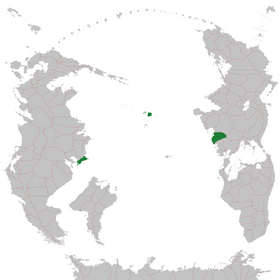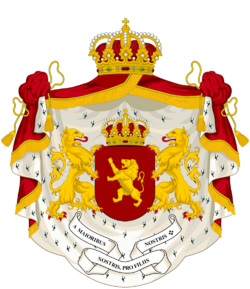Stoinia (Pacifica): Difference between revisions
Tag: 2017 source edit |
No edit summary Tag: 2017 source edit |
||
| Line 12: | Line 12: | ||
|alt_flag2 = <!--alt text for second flag--> | |alt_flag2 = <!--alt text for second flag--> | ||
|flag2_border = <!--set to no to disable border around the flag--> | |flag2_border = <!--set to no to disable border around the flag--> | ||
|image_coat = | |image_coat = Stoinia Small CoA.png <!--e.g. Coat of arms of country.svg--> | ||
|alt_coat = <!--alt text for coat of arms--> | |alt_coat = <!--alt text for coat of arms--> | ||
|symbol_type = [[Coat of arms of Stoinia(Pacifica)|Coat of arms]] <!--emblem, seal, etc (if not a coat of arms)--> | |symbol_type = [[Coat of arms of Stoinia (Pacifica)|Coat of arms]] <!--emblem, seal, etc (if not a coat of arms)--> | ||
|national_motto = "''A maioribus nostris, pro filiis nostris.''" <!--in inverted commas and wikilinked if link exists--> | |national_motto = "''A maioribus nostris, pro filiis nostris.''" <!--in inverted commas and wikilinked if link exists--> | ||
|englishmotto = <small>"''By our forefathers, for our children.''"</small> <!--English language version of motto--> | |englishmotto = <small>"''By our forefathers, for our children.''"</small> <!--English language version of motto--> | ||
|national_anthem = ''Marșul Regal''<br>''<small>Royal March</small>'' <!--in inverted commas and wikilinked if link exists--> | |national_anthem = ''Marșul Regal''<br>''<small>Royal March</small>'' <!--in inverted commas and wikilinked if link exists--> | ||
|royal_anthem = ''Trăiască Regele!''<br>''<small>Long live the King!</small>'' <!--in inverted commas and wikilinked if link exists--> | |royal_anthem = ''Trăiască Regele!''<br>''<small>Long live the King!</small>'' <!--in inverted commas and wikilinked if link exists--> | ||
|other_symbol_type = | |other_symbol_type = Royal Coat of Arms <!--Use if a further symbol exists, e.g. hymn--> | ||
|other_symbol = | |other_symbol = [[File:Coat of Arms Kingdom of Stoinia.png|250px]] | ||
|image_map = [[File:WikiStoiniaProjectionMap.png|frameless|280px]] <!--e.g. LocationCountry.svg--> | |image_map = [[File:WikiStoiniaProjectionMap.png|frameless|280px]] <!--e.g. LocationCountry.svg--> | ||
|loctext = <!--text description of location of country--> | |loctext = <!--text description of location of country--> | ||
Revision as of 14:23, 7 February 2023
Kingdom of Stoinia Regatul Stoiniei (Stoinian) | |
|---|---|
Motto: "A maioribus nostris, pro filiis nostris." "By our forefathers, for our children." | |
Anthem: Marșul Regal Royal March Royal anthem: Trăiască Regele! Long live the King! | |
 Location of Stoinia (dark green) | |
| Capital and largest city | Sinaia |
| Official languages | Tarnese (Stoinian speech) |
| Ethnic groups | 93.6% Stoinian 1,7% Ezervulgish 1,2% Myrian 3.5% other |
| Religion | 86,8% Christianity —92,4% Stoinian Orthodoxy —7,6% Other Christian faiths 11,7% Non-religious 1.5% Other/unknown |
| Demonym(s) | Stoinian |
| Government | Unitary Constitutional Monarchy |
• King | Andrei III |
• Prime Minister | Gheorghe Vlaicu |
• Minister of Foreign Affairs | Tiberiu Mocanu |
• WF Ambassador | Tudor Segărceanu |
| Legislature | Parliament |
| Senate | |
| Chamber of Deputies | |
| Formation | |
| Area | |
• Total | 123.339 km2 (47.621 sq mi) |
• Water (%) | 3.5 |
| Population | |
• 2022 census | 36.014.988 |
• Density | 292/km2 (756.3/sq mi) |
| GDP (nominal) | estimate |
• Total | $ 2,06 trillion (Đ 1,70 trillion) |
• Per capita | $ 57.208,22 (Đ 47.267,80) |
| Gini | 36.2 medium |
| HDI | 0.94 very high |
| Currency | Stoinian Dinar (Đ) (DIN) |
| Time zone | UTC+2 (CBT) |
| Date format | 18/05/953 CE |
| Driving side | right |
| World Forum Code | STO |
| Internet TLD | .sto |
"The river flows and flows, yet its stones remain unruffled. Withal, Stoinia is one such rock."—Stoinian proverb
Etymology
History
Prehistory
Little is known of the prehistory within Stoinian lands. It was filled with many different hunter-gatherer tribes until the arrival of the Proto-Tolosan ethnic group which came from northern lands. Although cities were founded, none held any considerable dominion beyond their walls.
Tolosan Republic
Roughly 1.000 BCE, such a city came to prominence. Tolosa (Pacifica) was the first city of marble and wealth within Stoinian lands. They began to expand their influence through trade and commerce, spiralling themselves and their neighbouring cities into the iron age. With this change, Tolosa formed a trade Republic ruled over by the wealthy families. As the wealth of the Tolosan Republic increased, so did their ambitions. The Tolosans began to found colonies and conquer neighbouring cities in the name of their Republic. This Republic would then stand firmly as the most dominant power within the current Stoinian lands, forging alliances and pacts with the trading powers of the Mediterranean sea. Most notable with proto-Sedunnic Dures (Pacifica)
Middle ages
The Stoinian middle ages began when the city of Tolosa was raised to the ground by the migrating proto-Ezervulgish people in 427 CE. This nomadic tribe were so ruthless in their conquest that all the Tolosan infrastructure was destroyed and brought the different Tolosan cities into a dark age. The remaining cities built their own kingdoms and fought against each other over food and land. A few clans however decided to settle north of the XXX mountains, creating an enclave in the homogenous Tolosan lands. The cities too were transformed as did the culture of their peoples. Many cities too converted from the Tolosan Sun deity to Christianity as their new faith. However, these cities would be reunited under one banner roughly 800 years after the fall of Tolosa.
Unification
Voievod Alexandru of Sinaia would become the first Sinaian King that would be granted the opportunity to unite all the Stoinian Kingdoms. It would take his entire lifetime to complete the task through warfare and realpolitik. Through hard work and a campaign of roughly twenty years, Alexandru reformed the different kingdoms into a new kingdom called Stoinia. Proclaiming a new Kingdom and all its people reborn in 1.222 CE, the Kingdom of Stoinia was founded and began consolidating and rebuilding itself on the south-western parts of the Bailtemmic continent. Becoming a close and trusting ally of Sedunn (Pacifica) for much of its history.
Szégyőr War
Ten years after Peter I's War (Pacifica), the Ezervulgish King Peter II grew up with the Sedunnic victory and saw the despair it brought to his country. Wishing to reaffirm Ezervulgy as a dominant power despite its recent defeat by his father's hand, he decided that the key to Ezervulgish industrialization was through the conquest of industrialized Stoinian lands. With the Szégyőr enclave from old, Peter II set out to campaign against the Stoinians under a pan-Ezervulgish ideology. Thus war was declared in 1896. The war was mostly fought in the region between the Olt and Milcov rivers. After multiple years of fighting, the Stoinians were able to repel the Ezervulgish invasion. The war remains a catalyst for Stoinian-Ezervulgish tension.
Red Calamity
In the early half of the 20th century, communism arose in the South Pacific. A new promise had seemingly grown with the Stoinian people when the communist party had gained substantial support. Growing bolder as the largest party, the party fell under radical leadership which began to call to depose the King and form a Socialist Republic. However, the King won public support and averted the outbreak of a civil war by exiling the communist politicians. However, these politicians would instead make their way to the eastern parts of Sallodesia (Pacifica) and instigate a communist rebellion. Wishing to make ammends, Stoinia recognized the young Sallodesian state and actively helped to repress the communist rebellion.


